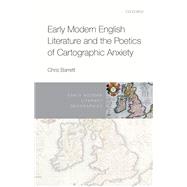
Early Modern English Literature and the Poetics of Cartographic Anxiety
by Chris BarrettRent Textbook
Rent Digital
New Textbook
We're Sorry
Sold Out
Used Textbook
We're Sorry
Sold Out
Summary
A product of a military arms race, often deployed for security and surveillance purposes, and fundamentally distortive of their subjects, maps provoked suspicion, unease, and even hostility in early modern Britain (in ways not dissimilar from the anxieties provoked by global positioning-enabled digital mapping in the twenty-first century). At the same time, writers saw in the resistance to cartographic logics and strategies the opportunity to rethink the way literature represents spaceand everything else. This volume explores three major poems of the periodEdmund Spenser's The Faerie Queene (1590, 1596), Michael Drayton's Poly-Olbion (1612, 1622), and John Milton's Paradise Lost (1667, 1674)in terms of their vexed and vexing relationships with cartographic materials, and shows how the productive protest staged by these texts redefined concepts of allegory, description, personification, bibliographic materiality, narrative, temporality, analogy, and other elemental components of literary representations.
Author Biography
Chris Barrett, Assistant Professor of English, Louisiana State University
Chris Barrett is Assistant Professor of English at Louisiana State University, where she joined the faculty in 2012 after completing her doctoral degree in English at Harvard University. Her research and teaching interests include early modern English literature, especially Spenser and Milton; lyric and epic poetry; critical animal studies and ecocriticism; and geocritical approaches to literature. She is the author of articles and essays on Shakespeare, Spenser, and Milton, and her research has been supported by the Council on Research, the Newberry Library, the Folger Library, and Dumbarton Oaks Museum & Collection.
Table of Contents
Introduction: Mapping Anxiety in Early Modern English Literature
1. The Dream of an Unmappable Nation: Allegory, Cartography, and Spenser's Faerie Queene
2. Time River Body: Personification and Inappropriate Detail in Drayton's Poly-Olbion
3. Milton's Paradise Lost and the Atlas of Violence
Conclusion: Wonders in the Deep
An electronic version of this book is available through VitalSource.
This book is viewable on PC, Mac, iPhone, iPad, iPod Touch, and most smartphones.
By purchasing, you will be able to view this book online, as well as download it, for the chosen number of days.
Digital License
You are licensing a digital product for a set duration. Durations are set forth in the product description, with "Lifetime" typically meaning five (5) years of online access and permanent download to a supported device. All licenses are non-transferable.
More details can be found here.
A downloadable version of this book is available through the eCampus Reader or compatible Adobe readers.
Applications are available on iOS, Android, PC, Mac, and Windows Mobile platforms.
Please view the compatibility matrix prior to purchase.
